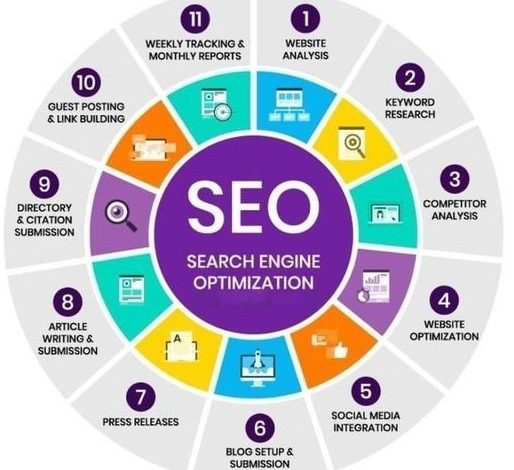Search Engine Optimization – What Is It?

SEO stands for Search engine optimization which involves writing and building content to help your blog rank highly on search engines like Google so that your target audience can recognize you as their authoritative source of information.
Now let’s look at the reasons why SEO is such a worthy investment: Therefore, bloggers can advertise their products and services, identify target consumers, and improve visitor numbers and revenue, ultimately. The fact is that to increase your site ranking in the SERPs there can be applied any number of SEO techniques.
It is important to consider your company’s goals, new changes made by the search engine and trends in the market when implementing an SEO plan. The task of Keyword research is now a fundamental requirement for every SEO strategy of blogging sites for any industry.

Search Engine Terms in Search Engine Optimization | What Are Keywords?
Search engines direct users to websites containing information they input through keywords. Browsers, especially the Google search engine, use keywords to understand the content of a website and relate it to queries from users. However, for many bloggers out there, organic traffic is the ultimate goal of blogging. This social phenomenon will attract more readers if you take steps such as using related blog keywords to optimize your content for search engines.
What Search Engine Optimization Terms Are Necessary for Your Blog?
If one is interested in attracting a specific audience to his or her blog, it becomes useful to research and employ the right keywords. These findings will also be valuable for creating an overall content marketing strategy to attract visitors for many years to come.

What are the best search engine optimization (SEO) keywords to use for website content?
You always have to know for whom you are writing. Platforms such as Google Analytics facilitate the discovery of details about your current audience, such as their age and how they interact with your website, to gain a deeper understanding of them. Next, once you understand the issues they face, you can analyze the keywords they use to delve deeper into the topic and utilize them effectively. Indeed, this is the point at which you should begin crafting content based on the keywords you uncover, in order to enhance your audience’s engagement.
What makes SEO keyword research important?
There are many benefits to researching the keywords on your website, as well as the following.
- Keyword research allows bloggers to identify topics that are interesting and relevant to their audience, helping them create valuable content.
- While your blog establishes itself as an authoritative pretty-desirable resource, optimizing it for the perfect keywords will increase your search engine score and help grow your domain authority.
- Getting in touch with your best customers and increasing conversions are all less difficult with the right keywords. To live on top of rising trends and make sure that your content is continually relevant
To make your content approach extra comprehensive, it is a very good concept to conduct key-word research to locate both evergreen and trending topics.
Steps to find blog keywords
Keyword research may seem like a daunting task for people who don’t know it. It is now relatively easy to learn how to handle keyword research in an article is not as difficult as you might think. We have collected satisfactory practices for finding blog keywords to encourage visitors and help your logo land.
Use special features
Search engine optimization (SEO) can be a time-consuming process due to the need to research and add keywords to posts. Use specialized tools to ensure keywords are relevant, monitor competitors, and find trending topics to maximize the effectiveness of the process.
Verifying your data.
Find out what keywords people are using to find your website in your listings. If you don’t have a dedicated post for these keywords, your best chance of getting more readers is to miss out.
You can use Google Suggests, a free and simple tool to find out what people are searching for the most. To see what the search engine recommends, just type in your keyword. By reading the keyword suggestions right at the bottom of each search results page, you can use Google to find relevant keywords.
Using Google Suggest to find relevant keywords
Google Trends is another useful tool for finding trending topics. Adjusting keywords by region, time, category, etc., as well as analyzing the number of searches over time are all possible with this tool.
Using Google Trends to find popular topics
Enter a word or phrase and search for the right keyword, or enter a page-marked keyword. Moz Keyword Explorer helps you in keyword discovery in two ways.
Having keywords in a question room can help you answer your audience’s questions as well.
Enter keywords or phrases into KeywordTool.io, and the site will return relevant keywords from multiple sources, including Google, Bing, YouTube, and Instagram.
Using Google Trends to find popular subjects
enter a word or phrase to get the relevant keyword, or enter the keyword the page is tagged with. Moz Keyword Explorer helps you in keyword discovery in two ways. Having keywords in the question design can also help you answer your audience’s questions.
Enter words or phrases into KeywordTool.io, and the website will return relevant keywords from multiple sources, including Google, Bing, YouTube, and Instagram.
Conducting keyword research using Search Engine Optimization
Without spending a dime on advertising, you can use the Google AdWords Keyword Planner to identify relevant keywords, measure search volume, and more.
A visual blog keyword generator that shows the keywords you enter is AnswerThePublic.com. This tool allows you to search for relevant keywords and add phrase structures to your posts.
Achieve Audience Harmony
Keyword research is incomplete without first knowing your target audience. If you take the time to dig deep, you can easily find the keywords your readers have been searching for. Establishing an audience persona that includes attributes such as demography, interests, problems, needs, etc is a good example. You can know more about your specific readership and this information is beneficial when developing content. However, you can also survey the audience, or just simply ask those who belong to your target niche to find more information. This should be inviting just long enough a survey as long as it is precise, and as interesting as possible: and offer something to the people who are participating in the survey. A subset of this can be coupons, special pricing rules, welcome page to new releases, etc. It’s also useful to keep track of consumers’ behavior toward the website.
In addition to doing keyword research and matching it to your audience, you should also check the relative strength of each keyword. The strength of a keyword is determined by the number and quality of links to the top ten pages in a particular search engine results page (SERP) In a nutshell, this score sheds light on the competitiveness of these pages through their link profiles are examined.
Moz, Ahrefs, and SEMrush are just a few tools that can help you determine the likelihood of ranking for a given keyword by testing its intensity on a scale from 1 to 100. For example, using Ahrefs, you can find out approximately how many backlinks you will need to rank well in search engines.
Assessing the Difficulty of a Keyword on Ahrefs
As a result, what award do you think you should aim for? Starting with keywords of 20–30 or less can be a good idea for aspiring bloggers whose websites do not have many domain rights.
 Verify the Number of Searches the number of searches for a particular keyword in a given period of time is called search volume. This metric lets you know about the monthly number of searches for a particular keyword. While it makes sense to use high-search keywords, pay attention to the quality of your keywords. If you want to reach a specific demographic, it’s best to use a simple keyword or phrase rather than a demanding one.
Verify the Number of Searches the number of searches for a particular keyword in a given period of time is called search volume. This metric lets you know about the monthly number of searches for a particular keyword. While it makes sense to use high-search keywords, pay attention to the quality of your keywords. If you want to reach a specific demographic, it’s best to use a simple keyword or phrase rather than a demanding one.
Dedicated functions can track searches for specific keywords. For example, Word Tracker displays an average monthly search volume.
Utilizing Word Tracker for Keyword Research
Word Stream analyzes a key query term in terms of search rankings and other metrics in both Google and Bing.
The proper use of the Word Stream to make research of the keywords
Keyword Combination Short-Tail and Long-Tail
There are many different criteria, with which the classification of keywords is possible, for example, by the number of words. A keyword string having more than two words is known as the long tail keyword whereas keywords having only a single or two words is called short tail keyword.
It is very difficult to rank short tail keywords because so many bloggers use it. However, it can be challenging to place long-tail keywords properly; they apply to a particular niche, and people visiting the site already have a particular idea in their mind.
Also, if you seek more organic traffic, long-tail keywords are good to go since they form parts of every search query. In case you do not have enough experience and knowledge of SEO, it is recommended to choose a topic that inspires you and make a few searches to discover long-tail keywords. I invite you to go to Google and type that word or phrase in and check what comes up. Once more, press the enter key, and you’ll be taken to the next page where you scroll down to discover more research at the bottom of the page.
Discovering additional search terms related to Google
Techniques in Keyword Research But spend some time and energy on finding the right keywords and on their combination. But getting the most effective results would require a proper planning of the entire process.
Search engine optimization (SEO) keywords can make or break your blog, so here are some signs:

- You should incorporate the use of keyword research tools as much as possible. There are SEO and keyword research tools designed to make a selection of the correct keywords for the topic easy. Moreover, they provide useful data such as a search trend, traffic, and many others simultaneously.
- Learn keyword research. You need to put your blog metrics in order so that you can benefit from learning about keywords using keyword research tools. For instance, the search volume will help to understand, the number of monthly searches for a particular keyword. There is also cost-per-click CPC, where with every click you make on the ads you have to pay a fixed fee.
3 .Focus on the right keywords. Blogging about popular keywords is often very competitive or nearly impossible for brand new bloggers to take on. Instead of those, you may use SEO keywords that have lower popularity level but are more suitable for your target audience. Increased traffic from your clients since your website authority will have improved.
- Incorporate low volume and high volume keywords. Short tail keywords are phrases with a high volume of traffic and a high level of competition. Thus, web site beginners may experience difficulty in gaining high ranking on those search engines in using such keywords. It is easier to reach your target audience with long-tail keywords, however, they are phrase and developed after some research on the web with both keywords for the results that a child has been enhanced.
As for the SEO strategy for blogs, three keywords which are optimal for a blog are
For writing blog, the best keywords are questions, informative articles, writing discussion posts, faqs, et cetera.
There is no doubt that SEO strategy targets a large number of keywords for exposure to a larger market. Focus on the following points if you are interested in the proper expansion of your keyword strategy.
To reach a wider audience, a good SEO strategy should include a variety of keywords. The following are some suggestions for expanding your keyword strategy.
- I have some questions. People particularly when using the internet use questioners for their queries. Attempt to guess what questions your target people might have and then try to incorporate them into your speech.
- Frequently asked FAQ. Creating FAQs is a win-win: not only do you address your readers’ primary issues, but that precious ranking on the search engine is also on the line. Some of the search engines prefer this format because it delivers questions that are direct, and more structured.
3.Informal vocabulary. This is true depending on the field of biodiversity and the topic to do with it that you need to write. But for search engine optimization, it is beneficial to look at the questions of your target audience.
If you want to reach more people through search engines, you need to include conversational keywords in your SEO strategy.
A Guide to Effective Keyword Utilization
As the blogging niche grows rapidly, new blogs pop up every day, making it more challenging to rank higher for a specific keyword In order to meet the demands of users and provide the right answers to their queries , Google is also constantly updating its algorithm. Search engine optimization (SEO) and the use of strategic keywords are a prerequisite to establishing your online presence and attracting visitors. Here are two ways:
Consider Your Keywords Before Writing
Be sure to focus your writing on specific keywords. They serve as input, and you are tasked with creating informative blog posts as output. Try to answer this question as thoroughly as possible without worrying about how to use the particular keyword in the finished text. Instead of cramming keywords into text at the last minute, it’s better to keep that in mind when you start writing.
It is crucial to have a grasp of the general search intent that people have while typing each of the keywords in question to create a high-quality blog post. This is what a user is looking for when he/she type something on the Google search engine.
Thus, if you want to respond to a given user question adequately, and make them progress to the sales funnel stage, you must determine their search intention. There are four main research purposes:
- Informs: People search for information because they want to know more about the topic.
- Navigational: Typically, these types of search queries use specific terms such as brand name, website name, location, and so on.
- Marketing: People recognize a particular brand, product, or service.
People who are looking for vendors tend to have a manufacturing mindset, which means they are ready to list.
So when you choose a keyword for a blog post and write matching text, keep search intent in mind, bringing users one step closer to writing a Reader searching for the “best winter spots.” on your website is just market research. Therefore, it doesn’t make sense to promote a particular hotel because it doesn’t address their query. On the other hand, a helpful article about top summer vacation destinations can hold the reader’s interest for a long time. Here you can advertise your advertiser products in detail for each location; If a user is interested in that location, they can click on the link to book a trip.
Discover the Appropriate Role
The key is to insert keywords throughout the text in an appropriate, not haphazard manner, so that they attract attention and help guide the user. Consider these suggestions:
- To start with, use keywords in the title, title and subtitle of your post. By using these keywords, you can increase your search engine ranking and make your content easier to read.
- Make sure your title tag contains the keyword, the title tag informs search engines about your page content and points you towards your target audience.
In any case, the keyword or its variation should be present in the main text of the post. Incorporate keywords into text (for instance, in meta descriptions, filenames and images alt text).
- Use internal linking to your advantage and add keywords to the anchor text.

Take Keyword Density into Account
Each blog post that bloggers decide to publish should have information relevant to specific keywords within a particular density rate. The keyword density of a blog post is best explained as the ratio of the number of words typed on the blog with respect to a particular keyword to the total number of words typed. It helps search engines in deciding as to whether the content available on its portal is relevant to a given query.
What should I do if my selection of keywords is large?
Take the quantity of times you are submitting your keyword in the post and divide it by the total quantity of words in the post then increase the outcome by 100. They could have gotten a keyword density of 5%, for instance the keyword five consecutive times within a page of say, one hundred words. Certain instruments like Sure Oak, Small SEO Tools, Yoast SEO Plugin etc., can help to evaluate the strength of the keywords. For instance, Small SEO Tools.
It offers the basic statistics like total keyword count, most frequent keywords as well as keywords in different ranks and tagged keywords cloud. Using Small SEO Tools, keyword research is done This article provides a conceptual paper on what are the most optimal metrics that should be aimed at. It also important with regards to the keyword density, and as most of the SEO experts have claimed, the perfect ratio of keywords is somewhere between one and two percent.
That is, one or two occurrences of your keyword for every hundred words it is the repetition density of a keyword. If you do not use keyword stuffing this will make search engines much more aware of your page. Furthermore, find out the keyword density of the other ten related terms for your target keyword in the search window. There is always something to think about when focusing on this.
Here writing with the reader in mind and using key words as in prior examples occurs quite naturally. It is can be quite tempting to fill in the content with keywords in attempt to fool the search engines but all that does is looked spammy and unprofessional to the readers.
Imagine this: if you are reading a book and you come across the same word or phrase in succession you start to question the ability of the author. The same thing is applied to blog posts as well In this case, one can write blog posts on the basis of some principles that have been outlined by other writers. Always carry with you the reader in mind – they will not mind reading well-written notes. Apply Different Keywords

It is also useful to drive up the number of hits because search engines can find other words similar to the targeted keywords and phrase: ‘Similar phrases are conversions that can help to optimize text, facilitate reading and increase traffic’.
You would not want to overdo the use of right words and at the same time overdo the use of long-tail words at the tail. If you want to rank higher for the term “travel solo” in a post, you can replace keywords such as ‘independent travel’ or ‘travel alone’.
Where can these variants be located?
Use relevant keyword tools like Kmeta, KW Finder, and Ubersuggest. For example, Kmeta provides detailed data about keywords related to the term you’re targeting.
Investigating keywords using Kmeta
Principles of Effective Blog SEO
You can use various search engine optimization strategies to improve your blog’s visibility in search results and attract more readers. If you want to grow your blog faster, you need to focus on implementing SEO best practices as some of these strategies are more effective than others.
Examine Who You Hope to Reach
If you want search engine optimization to work, you need to remember who you’re writing for and use every means to help your ideal customer find your content. You can zero in on the most relevant keywords, topics, and strategies to gain insight into your audience’s needs, pain points, and how you can help them find solutions
Execute Research on Keywords
If you want search engine optimization to work, you need to remember who you’re writing for and use every means possible to help your ideal customer find your content. You can zero in on the most relevant keywords and channels to gain insights into needs, pain points and how you can help your audience find solutions
Make Use of Images
Use of pictures and videos in the article can help to catch the reader’s attention and nail your message. Moreover, they raise your every possibility of entering into search engine results through the frequent keyword joining. There’s nothing wrong with making it easy for both people and search engines to understand what your content is about, it seems only right to add title and custom text to every picture. Doing so if also advisable to note the need to ensure that your text can be read by someone with low vision.
Offer original material
Helping people find interesting and useful content is one of Google’s main goals. This is why the platform gives more weight to blogs that frequently post updates. Blog posts should be as original and helpful to readers as possible.
Include headers
Structure your content with topics like H2, H3, and H4 and make it easy to navigate. These allow you to use more keywords and will show you the sequence of text. By using headlines, search engines can better understand the structure of your content and send more qualified visitors.
Compose brief phrases and paragraphs
Excessively long syntactic structures may be difficult to understand. State your point clearly and concisely so as not to confuse your audience. A good rule of thumb is to detail only one point per paragraph.
Include numbered lists and bullet points.
Thus the results of a set of related actions or factors can be well defined. Optimizing your posts for Google’s featured snippets is another benefit.
Insert a call-to-action
Use appropriate call to actions (CTAs) for the purpose of your blog post. People use these words and phrases to subscribe to the newsletter, sign up, fill out forms and more
A typical call-to-action is a brightly colored button that clicks and takes the user to a specific page such as a giveaway page.
What Influences Blog SEO?
When it comes to promoting a blog post to the first page of a search engine there are several options, for instance on page and off-page content. Ranking considerations are as follows;

- Website presentation. One thing that could be most crucial to the success of your blog is the speed of the pages in your blog. If for instance the page is opened quickly, the visitors of the site tend to read the content of the page to the end. Make sure that the timings as far as page loading is concerned does not go beyond the three seconds; if it does, visitors can simply click.
- Installation of materials. Dwell time is important for user experience, but not for ranking. From the time someone looks at your blog link in search results to clicking away from your page, this is the amount of time a user spends on your page. Search engines use dwell time to rate your content worthiness, which is subjective.
- Mobile version support. Especially when more and more of the traffic is coming from mobile devices, questions of mobile responsiveness are only becoming more important. Keep in mind that smaller posts might look different on the audience’s mobile devices because they can use their phones or tablets to browse your content. These may include things like modifying text formatting of images and other graphical edits.
- Current Information. But if you want the search engines to see your website as an authoritative source they should find the content useful and updated in the readers’ perspective.
Tips for Making Your Blog Posts More Visible in Search Results
Remembering what search engine algorithms are and being keen to make the content to match these algorithms will help in ranking. Use the following tips if you want the search engines to quickly pick your blog post.
1 .Keyword research should not be missing in your content marketing plan. But if your goal is to attract more people through a search engine, it is good to know what people type when looking up information about a certain topic. That way your work will be visible when someone is typing those specific keywords into the search engine.
- It is recommended that the content is updated frequently. Specifically, relative to the goal of most search engines – to maintain a database with the most current information available. So it’s the new content that is important to them. Be accurate and update on publication dates of posts and ensure that in the blog posts you are putting out, are well timed.
- Ensure that search engines crawl your post, in the event your audience cannot find it. To check if your page is indexed by Google or such other search engine you can use any web analytics tool or almost any builder used to build the website. Because mistakes are bound to occur when the index is created, it should be checked so that they may be corrected as soon as possible.
- At the same time make sure you provide your blog posts with an interesting title. The titles are useful in assisting readers in the sense making process by providing an account on what is showcased. It is also gives you extra chances to use keywords and is a component of Search Engine Optimization.

In summary,
When creating and improving content and finding the audience for it stay focused on the valuable which you bring through the blog. The things that you should target should be the ability to help your readers and to be easy to index since seeking to improve usability and optimizing for the search is done. So doing will help make you get to the first page of Google search results faster.





